Unit 6 Assessment: Understanding Equality and Diversity in Healthcare
VerifiedAdded on 2023/06/18
|13
|3811
|185
Homework Assignment
AI Summary
This assignment focuses on understanding the importance of equality, diversity, and inclusion in the health sector, examining relevant legislation and codes of practice, and exploring how to work in ways that support these principles. It defines key terms such as diversity, equality, inclusion, and discrimination, and discusses the benefits of a diverse workforce. The assignment also identifies key legislation like the Equality Act 2010 and the Human Rights Act 1998, explaining how they protect individuals from discrimination. Furthermore, it addresses practical scenarios, providing ways to treat people fairly according to their individual needs and preferences, and highlights factors contributing to diversity in healthcare settings, while also discussing how direct and indirect discrimination may occur.
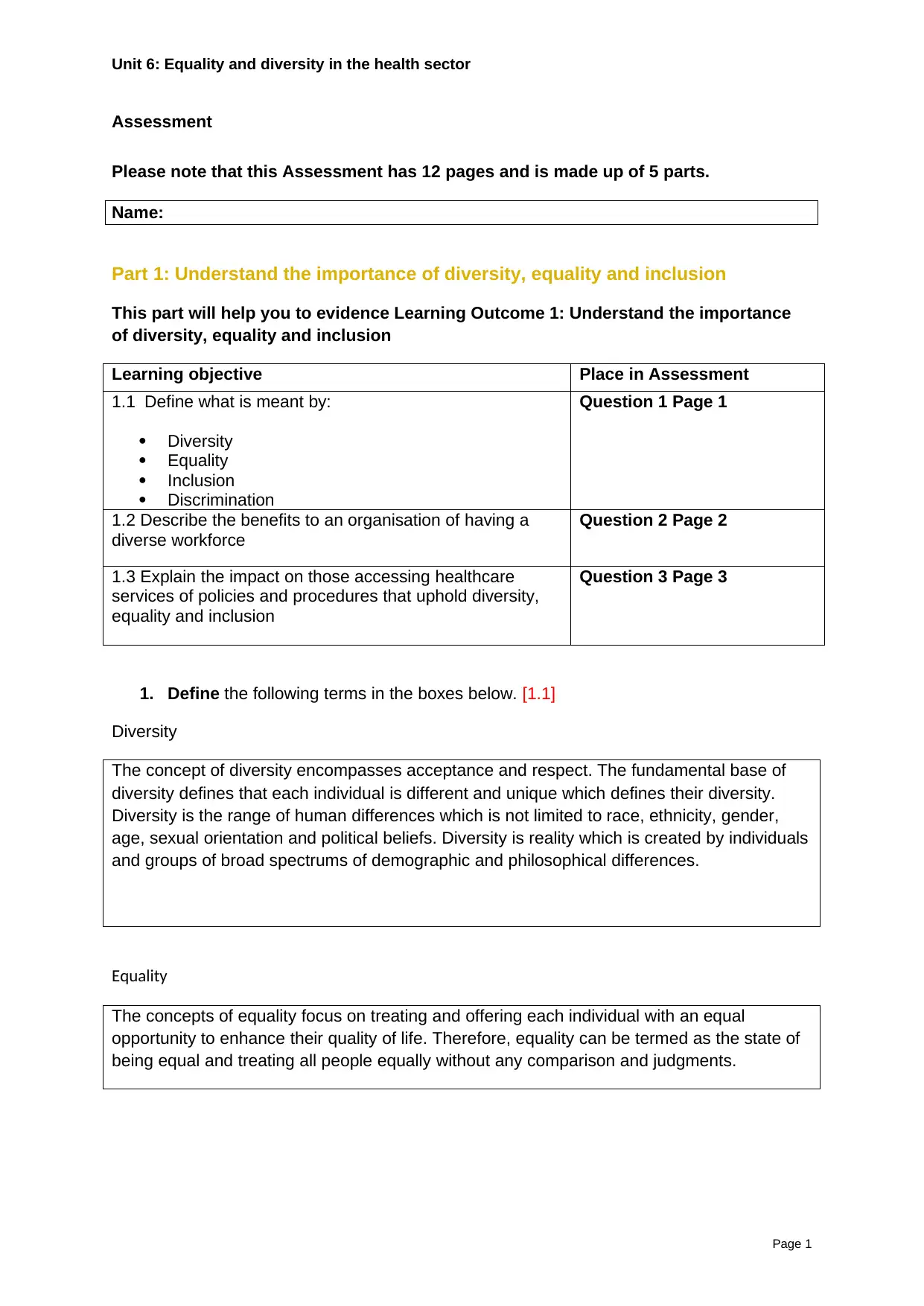
Unit 6: Equality and diversity in the health sector
Assessment
Please note that this Assessment has 12 pages and is made up of 5 parts.
Name:
Part 1: Understand the importance of diversity, equality and inclusion
This part will help you to evidence Learning Outcome 1: Understand the importance
of diversity, equality and inclusion
Learning objective Place in Assessment
1.1 Define what is meant by:
Diversity
Equality
Inclusion
Discrimination
Question 1 Page 1
1.2 Describe the benefits to an organisation of having a
diverse workforce
Question 2 Page 2
1.3 Explain the impact on those accessing healthcare
services of policies and procedures that uphold diversity,
equality and inclusion
Question 3 Page 3
1. Define the following terms in the boxes below. [1.1]
Diversity
The concept of diversity encompasses acceptance and respect. The fundamental base of
diversity defines that each individual is different and unique which defines their diversity.
Diversity is the range of human differences which is not limited to race, ethnicity, gender,
age, sexual orientation and political beliefs. Diversity is reality which is created by individuals
and groups of broad spectrums of demographic and philosophical differences.
Equality
The concepts of equality focus on treating and offering each individual with an equal
opportunity to enhance their quality of life. Therefore, equality can be termed as the state of
being equal and treating all people equally without any comparison and judgments.
Page 1
Assessment
Please note that this Assessment has 12 pages and is made up of 5 parts.
Name:
Part 1: Understand the importance of diversity, equality and inclusion
This part will help you to evidence Learning Outcome 1: Understand the importance
of diversity, equality and inclusion
Learning objective Place in Assessment
1.1 Define what is meant by:
Diversity
Equality
Inclusion
Discrimination
Question 1 Page 1
1.2 Describe the benefits to an organisation of having a
diverse workforce
Question 2 Page 2
1.3 Explain the impact on those accessing healthcare
services of policies and procedures that uphold diversity,
equality and inclusion
Question 3 Page 3
1. Define the following terms in the boxes below. [1.1]
Diversity
The concept of diversity encompasses acceptance and respect. The fundamental base of
diversity defines that each individual is different and unique which defines their diversity.
Diversity is the range of human differences which is not limited to race, ethnicity, gender,
age, sexual orientation and political beliefs. Diversity is reality which is created by individuals
and groups of broad spectrums of demographic and philosophical differences.
Equality
The concepts of equality focus on treating and offering each individual with an equal
opportunity to enhance their quality of life. Therefore, equality can be termed as the state of
being equal and treating all people equally without any comparison and judgments.
Page 1
Paraphrase This Document
Need a fresh take? Get an instant paraphrase of this document with our AI Paraphraser
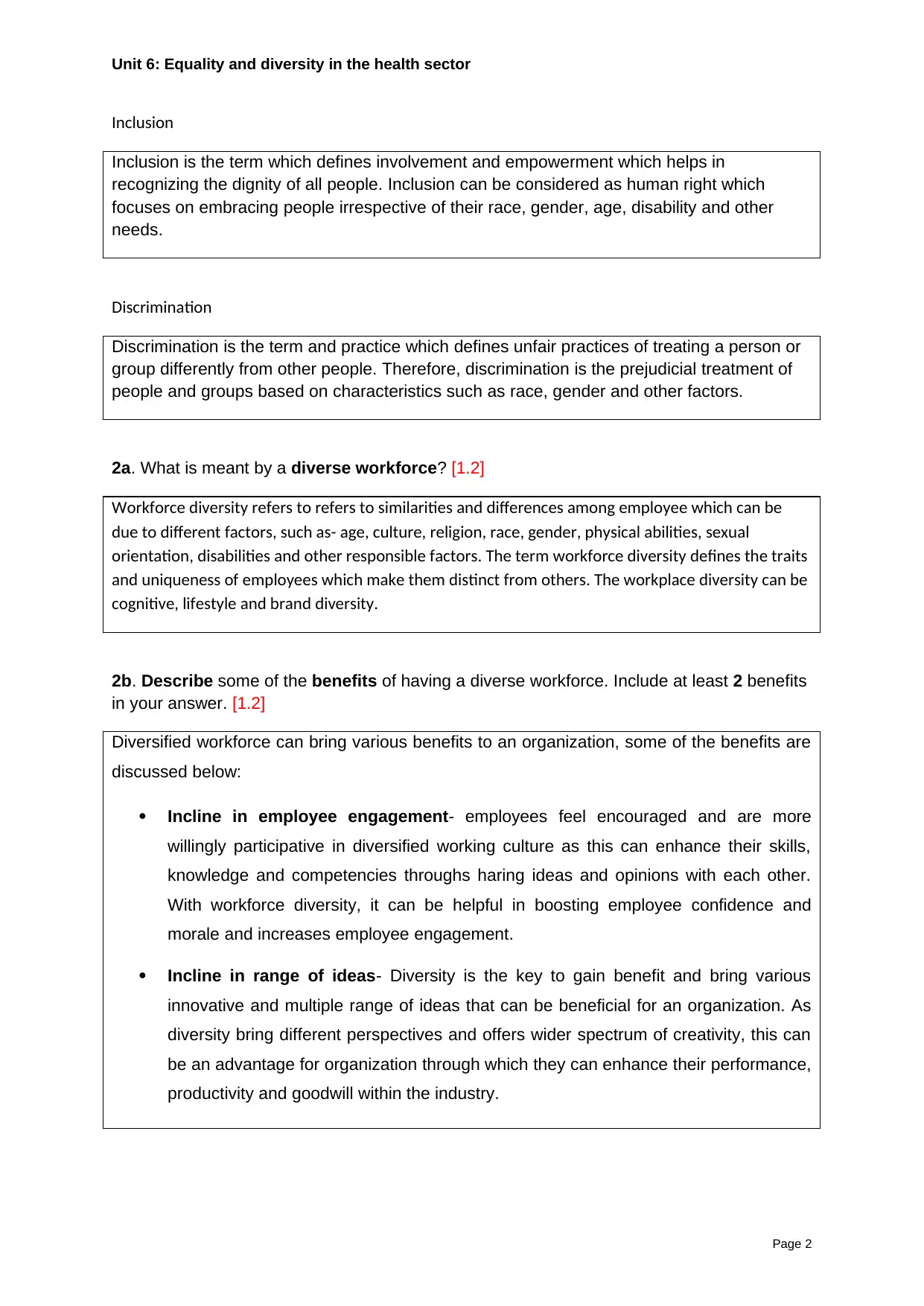
Unit 6: Equality and diversity in the health sector
Inclusion
Inclusion is the term which defines involvement and empowerment which helps in
recognizing the dignity of all people. Inclusion can be considered as human right which
focuses on embracing people irrespective of their race, gender, age, disability and other
needs.
Discrimination
Discrimination is the term and practice which defines unfair practices of treating a person or
group differently from other people. Therefore, discrimination is the prejudicial treatment of
people and groups based on characteristics such as race, gender and other factors.
2a. What is meant by a diverse workforce? [1.2]
Workforce diversity refers to refers to similarities and differences among employee which can be
due to different factors, such as- age, culture, religion, race, gender, physical abilities, sexual
orientation, disabilities and other responsible factors. The term workforce diversity defines the traits
and uniqueness of employees which make them distinct from others. The workplace diversity can be
cognitive, lifestyle and brand diversity.
2b. Describe some of the benefits of having a diverse workforce. Include at least 2 benefits
in your answer. [1.2]
Diversified workforce can bring various benefits to an organization, some of the benefits are
discussed below:
Incline in employee engagement- employees feel encouraged and are more
willingly participative in diversified working culture as this can enhance their skills,
knowledge and competencies throughs haring ideas and opinions with each other.
With workforce diversity, it can be helpful in boosting employee confidence and
morale and increases employee engagement.
Incline in range of ideas- Diversity is the key to gain benefit and bring various
innovative and multiple range of ideas that can be beneficial for an organization. As
diversity bring different perspectives and offers wider spectrum of creativity, this can
be an advantage for organization through which they can enhance their performance,
productivity and goodwill within the industry.
Page 2
Inclusion
Inclusion is the term which defines involvement and empowerment which helps in
recognizing the dignity of all people. Inclusion can be considered as human right which
focuses on embracing people irrespective of their race, gender, age, disability and other
needs.
Discrimination
Discrimination is the term and practice which defines unfair practices of treating a person or
group differently from other people. Therefore, discrimination is the prejudicial treatment of
people and groups based on characteristics such as race, gender and other factors.
2a. What is meant by a diverse workforce? [1.2]
Workforce diversity refers to refers to similarities and differences among employee which can be
due to different factors, such as- age, culture, religion, race, gender, physical abilities, sexual
orientation, disabilities and other responsible factors. The term workforce diversity defines the traits
and uniqueness of employees which make them distinct from others. The workplace diversity can be
cognitive, lifestyle and brand diversity.
2b. Describe some of the benefits of having a diverse workforce. Include at least 2 benefits
in your answer. [1.2]
Diversified workforce can bring various benefits to an organization, some of the benefits are
discussed below:
Incline in employee engagement- employees feel encouraged and are more
willingly participative in diversified working culture as this can enhance their skills,
knowledge and competencies throughs haring ideas and opinions with each other.
With workforce diversity, it can be helpful in boosting employee confidence and
morale and increases employee engagement.
Incline in range of ideas- Diversity is the key to gain benefit and bring various
innovative and multiple range of ideas that can be beneficial for an organization. As
diversity bring different perspectives and offers wider spectrum of creativity, this can
be an advantage for organization through which they can enhance their performance,
productivity and goodwill within the industry.
Page 2

Unit 6: Equality and diversity in the health sector
3. What is the impact of policies and procedures that uphold diversity, equality and
inclusion on individuals accessing healthcare services? Use a policy or procedure as an
example in your answer. [1.3]
The influence of policies and procedures that promote diversity, equality, and inclusion, as
well as laws and guidelines, on the boundaries that businesses can follow. Maintaining the
dignity and respect of others. The confidentiality policy establishes the guidelines for
preventing or limiting access to certain data or places.
For example, equal opportunity guidelines will explain the actions a healthcare organisation
must take to comply with the 2010 Equality Act.
Page 3
3. What is the impact of policies and procedures that uphold diversity, equality and
inclusion on individuals accessing healthcare services? Use a policy or procedure as an
example in your answer. [1.3]
The influence of policies and procedures that promote diversity, equality, and inclusion, as
well as laws and guidelines, on the boundaries that businesses can follow. Maintaining the
dignity and respect of others. The confidentiality policy establishes the guidelines for
preventing or limiting access to certain data or places.
For example, equal opportunity guidelines will explain the actions a healthcare organisation
must take to comply with the 2010 Equality Act.
Page 3
⊘ This is a preview!⊘
Do you want full access?
Subscribe today to unlock all pages.

Trusted by 1+ million students worldwide
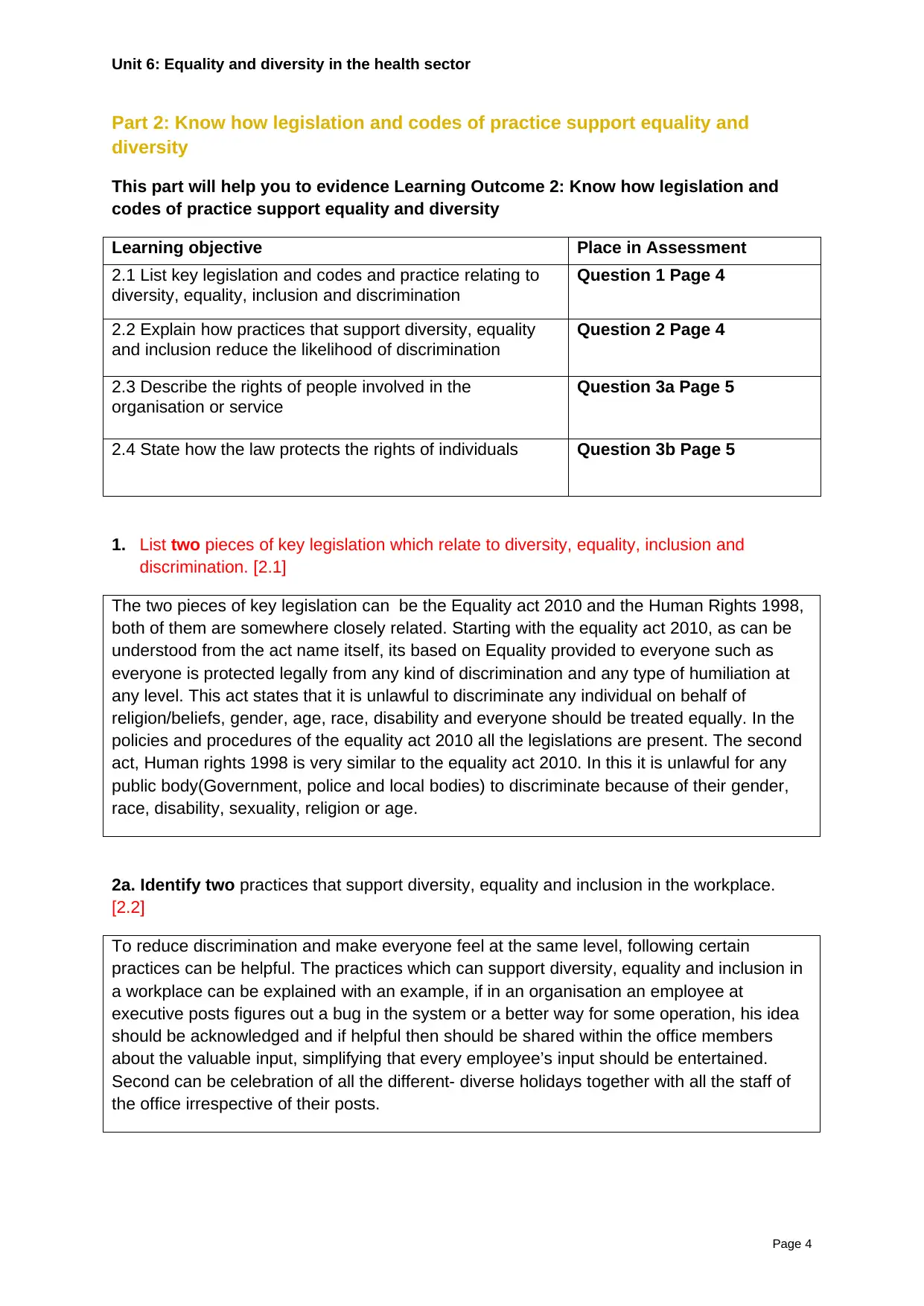
Unit 6: Equality and diversity in the health sector
Part 2: Know how legislation and codes of practice support equality and
diversity
This part will help you to evidence Learning Outcome 2: Know how legislation and
codes of practice support equality and diversity
Learning objective Place in Assessment
2.1 List key legislation and codes and practice relating to
diversity, equality, inclusion and discrimination
Question 1 Page 4
2.2 Explain how practices that support diversity, equality
and inclusion reduce the likelihood of discrimination
Question 2 Page 4
2.3 Describe the rights of people involved in the
organisation or service
Question 3a Page 5
2.4 State how the law protects the rights of individuals Question 3b Page 5
1. List two pieces of key legislation which relate to diversity, equality, inclusion and
discrimination. [2.1]
The two pieces of key legislation can be the Equality act 2010 and the Human Rights 1998,
both of them are somewhere closely related. Starting with the equality act 2010, as can be
understood from the act name itself, its based on Equality provided to everyone such as
everyone is protected legally from any kind of discrimination and any type of humiliation at
any level. This act states that it is unlawful to discriminate any individual on behalf of
religion/beliefs, gender, age, race, disability and everyone should be treated equally. In the
policies and procedures of the equality act 2010 all the legislations are present. The second
act, Human rights 1998 is very similar to the equality act 2010. In this it is unlawful for any
public body(Government, police and local bodies) to discriminate because of their gender,
race, disability, sexuality, religion or age.
2a. Identify two practices that support diversity, equality and inclusion in the workplace.
[2.2]
To reduce discrimination and make everyone feel at the same level, following certain
practices can be helpful. The practices which can support diversity, equality and inclusion in
a workplace can be explained with an example, if in an organisation an employee at
executive posts figures out a bug in the system or a better way for some operation, his idea
should be acknowledged and if helpful then should be shared within the office members
about the valuable input, simplifying that every employee’s input should be entertained.
Second can be celebration of all the different- diverse holidays together with all the staff of
the office irrespective of their posts.
Page 4
Part 2: Know how legislation and codes of practice support equality and
diversity
This part will help you to evidence Learning Outcome 2: Know how legislation and
codes of practice support equality and diversity
Learning objective Place in Assessment
2.1 List key legislation and codes and practice relating to
diversity, equality, inclusion and discrimination
Question 1 Page 4
2.2 Explain how practices that support diversity, equality
and inclusion reduce the likelihood of discrimination
Question 2 Page 4
2.3 Describe the rights of people involved in the
organisation or service
Question 3a Page 5
2.4 State how the law protects the rights of individuals Question 3b Page 5
1. List two pieces of key legislation which relate to diversity, equality, inclusion and
discrimination. [2.1]
The two pieces of key legislation can be the Equality act 2010 and the Human Rights 1998,
both of them are somewhere closely related. Starting with the equality act 2010, as can be
understood from the act name itself, its based on Equality provided to everyone such as
everyone is protected legally from any kind of discrimination and any type of humiliation at
any level. This act states that it is unlawful to discriminate any individual on behalf of
religion/beliefs, gender, age, race, disability and everyone should be treated equally. In the
policies and procedures of the equality act 2010 all the legislations are present. The second
act, Human rights 1998 is very similar to the equality act 2010. In this it is unlawful for any
public body(Government, police and local bodies) to discriminate because of their gender,
race, disability, sexuality, religion or age.
2a. Identify two practices that support diversity, equality and inclusion in the workplace.
[2.2]
To reduce discrimination and make everyone feel at the same level, following certain
practices can be helpful. The practices which can support diversity, equality and inclusion in
a workplace can be explained with an example, if in an organisation an employee at
executive posts figures out a bug in the system or a better way for some operation, his idea
should be acknowledged and if helpful then should be shared within the office members
about the valuable input, simplifying that every employee’s input should be entertained.
Second can be celebration of all the different- diverse holidays together with all the staff of
the office irrespective of their posts.
Page 4
Paraphrase This Document
Need a fresh take? Get an instant paraphrase of this document with our AI Paraphraser

Unit 6: Equality and diversity in the health sector
2b. Explain how the practices you identified in question 2a reduce the chances of
discrimination occurring in the workplace. [2.2]
The practices previously shared can impact greatly in reducing the chances of
discrimination, starting with the first example shared, in any organisation every employee
looks how the different posts candidates are being treated at the same time if an employee
at executive is praised because of his input which has been very helpful for the organisation
this shows the spirit of equality, that every individual is being acknowledged and accepted
irrespective of their posts and thus will create an environment of inclusion and equality. As
stated in the second practice, if the diverse holidays are celebrated together, the
understanding in the workspace if shared that there is no one as minority or majority as
every holiday is being respected and celebrated. As every individual has their own
perceptions and they have their own understanding of doing things, connecting to a
workplace where everyone is respected, valued will make every diverse candidate feel equal
and included.
3. Use the table below to:
a. Describe the rights of a range of individuals who have one or more of the 9 protected
characteristics in the organisation / service you work for (or one that you are familiar
with). [2.3]
b. Name the legislation and state how the law protects the rights of these individuals.
[2.4]
Individual
(colleague/manager
or service user) and
protected
characteristic
What are their
rights?
Legislation that
protects their rights
How does this
legislation protect
their rights?
Example 1
An employee looking
for promotion at the
same time who is
close to his
retirement
If the employee is
eligible to get
promoted he
should have every
opportunity to get
promotion
irrespective of his
age.
Because of their
age they should
not be treated
unfairly
Equality Act 2010 According to this act
it is unlawful if any
individual is treated
unfairly or is
discriminated on
basis of their age.
Example 2
A managerial post
The working space
(desk- table, chair,
Equality Act 2010 Irrespective of the
physical condition
Page 5
2b. Explain how the practices you identified in question 2a reduce the chances of
discrimination occurring in the workplace. [2.2]
The practices previously shared can impact greatly in reducing the chances of
discrimination, starting with the first example shared, in any organisation every employee
looks how the different posts candidates are being treated at the same time if an employee
at executive is praised because of his input which has been very helpful for the organisation
this shows the spirit of equality, that every individual is being acknowledged and accepted
irrespective of their posts and thus will create an environment of inclusion and equality. As
stated in the second practice, if the diverse holidays are celebrated together, the
understanding in the workspace if shared that there is no one as minority or majority as
every holiday is being respected and celebrated. As every individual has their own
perceptions and they have their own understanding of doing things, connecting to a
workplace where everyone is respected, valued will make every diverse candidate feel equal
and included.
3. Use the table below to:
a. Describe the rights of a range of individuals who have one or more of the 9 protected
characteristics in the organisation / service you work for (or one that you are familiar
with). [2.3]
b. Name the legislation and state how the law protects the rights of these individuals.
[2.4]
Individual
(colleague/manager
or service user) and
protected
characteristic
What are their
rights?
Legislation that
protects their rights
How does this
legislation protect
their rights?
Example 1
An employee looking
for promotion at the
same time who is
close to his
retirement
If the employee is
eligible to get
promoted he
should have every
opportunity to get
promotion
irrespective of his
age.
Because of their
age they should
not be treated
unfairly
Equality Act 2010 According to this act
it is unlawful if any
individual is treated
unfairly or is
discriminated on
basis of their age.
Example 2
A managerial post
The working space
(desk- table, chair,
Equality Act 2010 Irrespective of the
physical condition
Page 5
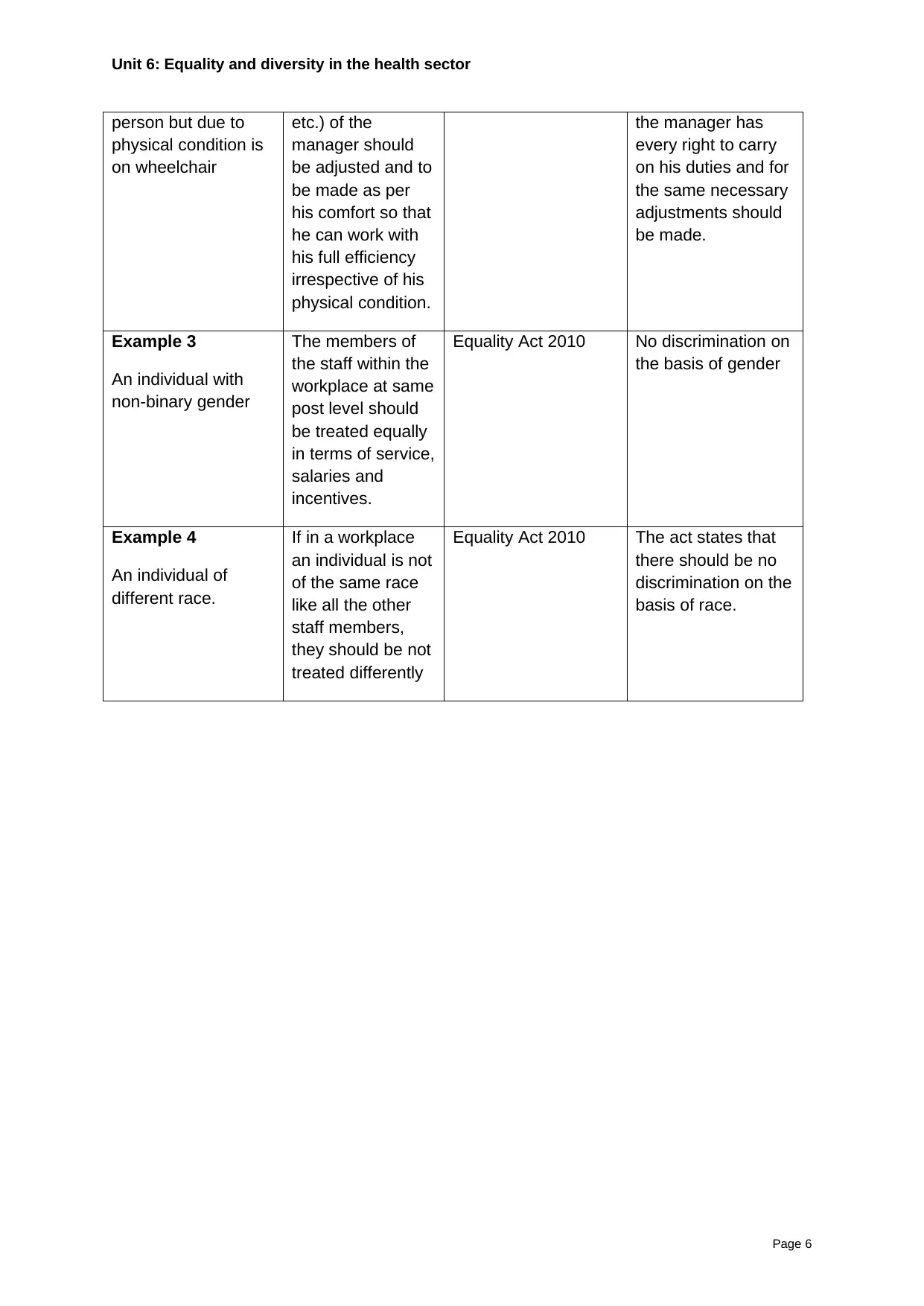
Unit 6: Equality and diversity in the health sector
person but due to
physical condition is
on wheelchair
etc.) of the
manager should
be adjusted and to
be made as per
his comfort so that
he can work with
his full efficiency
irrespective of his
physical condition.
the manager has
every right to carry
on his duties and for
the same necessary
adjustments should
be made.
Example 3
An individual with
non-binary gender
The members of
the staff within the
workplace at same
post level should
be treated equally
in terms of service,
salaries and
incentives.
Equality Act 2010 No discrimination on
the basis of gender
Example 4
An individual of
different race.
If in a workplace
an individual is not
of the same race
like all the other
staff members,
they should be not
treated differently
Equality Act 2010 The act states that
there should be no
discrimination on the
basis of race.
Page 6
person but due to
physical condition is
on wheelchair
etc.) of the
manager should
be adjusted and to
be made as per
his comfort so that
he can work with
his full efficiency
irrespective of his
physical condition.
the manager has
every right to carry
on his duties and for
the same necessary
adjustments should
be made.
Example 3
An individual with
non-binary gender
The members of
the staff within the
workplace at same
post level should
be treated equally
in terms of service,
salaries and
incentives.
Equality Act 2010 No discrimination on
the basis of gender
Example 4
An individual of
different race.
If in a workplace
an individual is not
of the same race
like all the other
staff members,
they should be not
treated differently
Equality Act 2010 The act states that
there should be no
discrimination on the
basis of race.
Page 6
⊘ This is a preview!⊘
Do you want full access?
Subscribe today to unlock all pages.

Trusted by 1+ million students worldwide
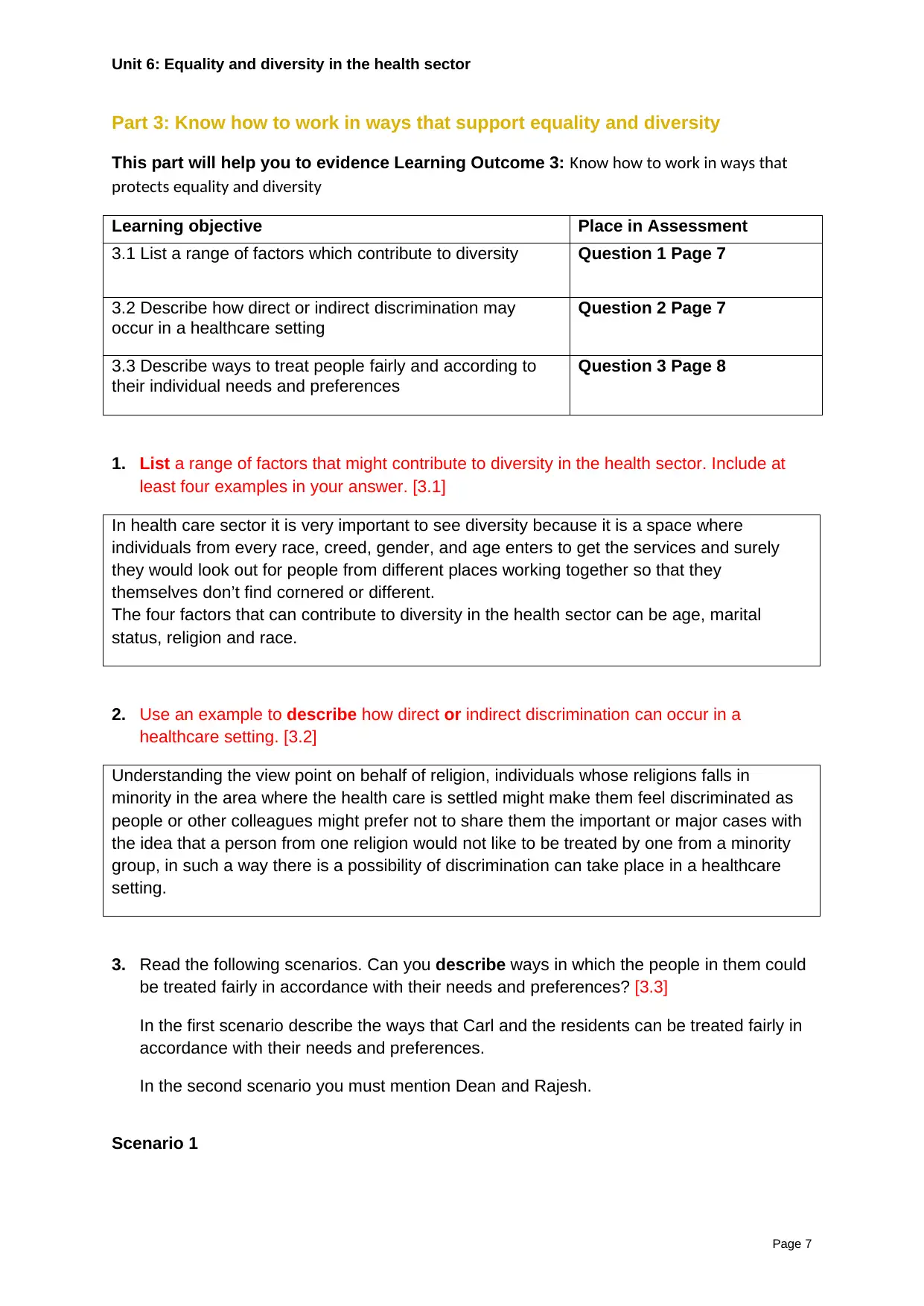
Unit 6: Equality and diversity in the health sector
Part 3: Know how to work in ways that support equality and diversity
This part will help you to evidence Learning Outcome 3: Know how to work in ways that
protects equality and diversity
Learning objective Place in Assessment
3.1 List a range of factors which contribute to diversity Question 1 Page 7
3.2 Describe how direct or indirect discrimination may
occur in a healthcare setting
Question 2 Page 7
3.3 Describe ways to treat people fairly and according to
their individual needs and preferences
Question 3 Page 8
1. List a range of factors that might contribute to diversity in the health sector. Include at
least four examples in your answer. [3.1]
In health care sector it is very important to see diversity because it is a space where
individuals from every race, creed, gender, and age enters to get the services and surely
they would look out for people from different places working together so that they
themselves don’t find cornered or different.
The four factors that can contribute to diversity in the health sector can be age, marital
status, religion and race.
2. Use an example to describe how direct or indirect discrimination can occur in a
healthcare setting. [3.2]
Understanding the view point on behalf of religion, individuals whose religions falls in
minority in the area where the health care is settled might make them feel discriminated as
people or other colleagues might prefer not to share them the important or major cases with
the idea that a person from one religion would not like to be treated by one from a minority
group, in such a way there is a possibility of discrimination can take place in a healthcare
setting.
3. Read the following scenarios. Can you describe ways in which the people in them could
be treated fairly in accordance with their needs and preferences? [3.3]
In the first scenario describe the ways that Carl and the residents can be treated fairly in
accordance with their needs and preferences.
In the second scenario you must mention Dean and Rajesh.
Scenario 1
Page 7
Part 3: Know how to work in ways that support equality and diversity
This part will help you to evidence Learning Outcome 3: Know how to work in ways that
protects equality and diversity
Learning objective Place in Assessment
3.1 List a range of factors which contribute to diversity Question 1 Page 7
3.2 Describe how direct or indirect discrimination may
occur in a healthcare setting
Question 2 Page 7
3.3 Describe ways to treat people fairly and according to
their individual needs and preferences
Question 3 Page 8
1. List a range of factors that might contribute to diversity in the health sector. Include at
least four examples in your answer. [3.1]
In health care sector it is very important to see diversity because it is a space where
individuals from every race, creed, gender, and age enters to get the services and surely
they would look out for people from different places working together so that they
themselves don’t find cornered or different.
The four factors that can contribute to diversity in the health sector can be age, marital
status, religion and race.
2. Use an example to describe how direct or indirect discrimination can occur in a
healthcare setting. [3.2]
Understanding the view point on behalf of religion, individuals whose religions falls in
minority in the area where the health care is settled might make them feel discriminated as
people or other colleagues might prefer not to share them the important or major cases with
the idea that a person from one religion would not like to be treated by one from a minority
group, in such a way there is a possibility of discrimination can take place in a healthcare
setting.
3. Read the following scenarios. Can you describe ways in which the people in them could
be treated fairly in accordance with their needs and preferences? [3.3]
In the first scenario describe the ways that Carl and the residents can be treated fairly in
accordance with their needs and preferences.
In the second scenario you must mention Dean and Rajesh.
Scenario 1
Page 7
Paraphrase This Document
Need a fresh take? Get an instant paraphrase of this document with our AI Paraphraser

Unit 6: Equality and diversity in the health sector
Carl is a care assistant at a residential care home. Another care assistant, Helen, has
worked there for a long time and is often not particularly fair to residents whose catering
needs are different from others. To vegetarians, she has been heard saying “Don’t you miss
bacon?” and to Jewish residents she has said “the chef will have to prepare yours differently
won’t she? That’s gonna take extra time for her.” She has also commented on Muslim
residents’ needs to fast at certain times of the year and to pray at certain times of the day.
Carl is uncomfortable when Helen does this and feels it may jeopardise his working
relationship with her.
Person How can they be treated
fairly?
How is this treatment in
accordance with their
needs?
Carl, care assistant Because of the wrongful
attitude of Helen in her
working space, she might
risk the job and also
jeopardise her working
relationship with Carl. A
care assistant is supposed
to help people with their
needs without judging them
and making them feel
anxious about things at the
same time Helen is one who
has been doing completely
opposite, Carl must whistle
blow about his colleague to
his manager.
Carl must speak to his direct
manager and make him
aware about the practices of
Helen, how she has been
treating people at the care
home, making them anxious
and carl has to cover her up.
He has every right to
complaint about his
colleague to maintain a
healthy environment for
himself and for the service
users.
Scenario 2
Dean has mild Downs Syndrome and enjoys an active and busy life with friends and family.
He has applied for a job as a hospital porter. The interview goes well but Dean does not get
the job. Dean’s friend Rajesh works at the hospital and tells Dean’s parents that he didn’t get
the job because the manager has preconceptions about the capabilities of people with
Downs Syndrome. Rajesh gets into trouble from his manager for speaking his mind and
revealing confidential information.
Person How can they be treated
fairly?
How is this treatment in
accordance with their
needs?
Dean, with mild Downs
Syndrome
Downs syndrome is a
genetic disorder which has
been there and Dean has
Taking a decision on
someone on basis of
something for which they
Page 8
Carl is a care assistant at a residential care home. Another care assistant, Helen, has
worked there for a long time and is often not particularly fair to residents whose catering
needs are different from others. To vegetarians, she has been heard saying “Don’t you miss
bacon?” and to Jewish residents she has said “the chef will have to prepare yours differently
won’t she? That’s gonna take extra time for her.” She has also commented on Muslim
residents’ needs to fast at certain times of the year and to pray at certain times of the day.
Carl is uncomfortable when Helen does this and feels it may jeopardise his working
relationship with her.
Person How can they be treated
fairly?
How is this treatment in
accordance with their
needs?
Carl, care assistant Because of the wrongful
attitude of Helen in her
working space, she might
risk the job and also
jeopardise her working
relationship with Carl. A
care assistant is supposed
to help people with their
needs without judging them
and making them feel
anxious about things at the
same time Helen is one who
has been doing completely
opposite, Carl must whistle
blow about his colleague to
his manager.
Carl must speak to his direct
manager and make him
aware about the practices of
Helen, how she has been
treating people at the care
home, making them anxious
and carl has to cover her up.
He has every right to
complaint about his
colleague to maintain a
healthy environment for
himself and for the service
users.
Scenario 2
Dean has mild Downs Syndrome and enjoys an active and busy life with friends and family.
He has applied for a job as a hospital porter. The interview goes well but Dean does not get
the job. Dean’s friend Rajesh works at the hospital and tells Dean’s parents that he didn’t get
the job because the manager has preconceptions about the capabilities of people with
Downs Syndrome. Rajesh gets into trouble from his manager for speaking his mind and
revealing confidential information.
Person How can they be treated
fairly?
How is this treatment in
accordance with their
needs?
Dean, with mild Downs
Syndrome
Downs syndrome is a
genetic disorder which has
been there and Dean has
Taking a decision on
someone on basis of
something for which they
Page 8

Unit 6: Equality and diversity in the health sector
no control over it, it can
effect Dean individually but
in terms of his performance
he can surely give his fullest
irrespective of his disorder.
themselves are not even
responsible is not the right
practice to followed, one
should be given a chance to
showcase their potential
Rajesh Sharing an information of
office about Dean to his
parents should not be
communicated by Rajesh, if
it was meant to be then the
Manager should have
himself communicated the
same.
As Rajesh has recently
joined, leaving him with a
trigger warning is the right
action to make him aware
what to follow.
Page 9
no control over it, it can
effect Dean individually but
in terms of his performance
he can surely give his fullest
irrespective of his disorder.
themselves are not even
responsible is not the right
practice to followed, one
should be given a chance to
showcase their potential
Rajesh Sharing an information of
office about Dean to his
parents should not be
communicated by Rajesh, if
it was meant to be then the
Manager should have
himself communicated the
same.
As Rajesh has recently
joined, leaving him with a
trigger warning is the right
action to make him aware
what to follow.
Page 9
⊘ This is a preview!⊘
Do you want full access?
Subscribe today to unlock all pages.

Trusted by 1+ million students worldwide
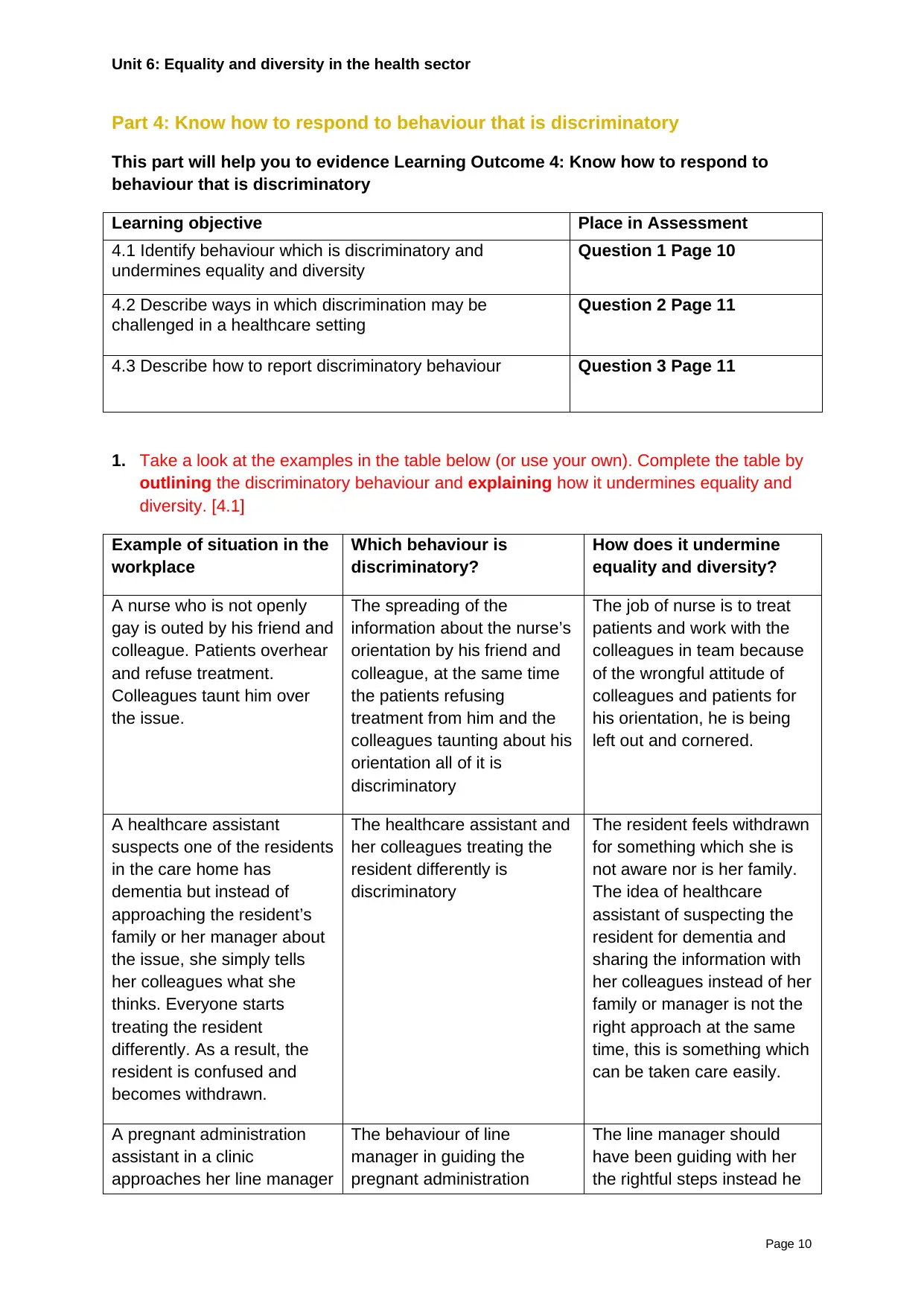
Unit 6: Equality and diversity in the health sector
Part 4: Know how to respond to behaviour that is discriminatory
This part will help you to evidence Learning Outcome 4: Know how to respond to
behaviour that is discriminatory
Learning objective Place in Assessment
4.1 Identify behaviour which is discriminatory and
undermines equality and diversity
Question 1 Page 10
4.2 Describe ways in which discrimination may be
challenged in a healthcare setting
Question 2 Page 11
4.3 Describe how to report discriminatory behaviour Question 3 Page 11
1. Take a look at the examples in the table below (or use your own). Complete the table by
outlining the discriminatory behaviour and explaining how it undermines equality and
diversity. [4.1]
Example of situation in the
workplace
Which behaviour is
discriminatory?
How does it undermine
equality and diversity?
A nurse who is not openly
gay is outed by his friend and
colleague. Patients overhear
and refuse treatment.
Colleagues taunt him over
the issue.
The spreading of the
information about the nurse’s
orientation by his friend and
colleague, at the same time
the patients refusing
treatment from him and the
colleagues taunting about his
orientation all of it is
discriminatory
The job of nurse is to treat
patients and work with the
colleagues in team because
of the wrongful attitude of
colleagues and patients for
his orientation, he is being
left out and cornered.
A healthcare assistant
suspects one of the residents
in the care home has
dementia but instead of
approaching the resident’s
family or her manager about
the issue, she simply tells
her colleagues what she
thinks. Everyone starts
treating the resident
differently. As a result, the
resident is confused and
becomes withdrawn.
The healthcare assistant and
her colleagues treating the
resident differently is
discriminatory
The resident feels withdrawn
for something which she is
not aware nor is her family.
The idea of healthcare
assistant of suspecting the
resident for dementia and
sharing the information with
her colleagues instead of her
family or manager is not the
right approach at the same
time, this is something which
can be taken care easily.
A pregnant administration
assistant in a clinic
approaches her line manager
The behaviour of line
manager in guiding the
pregnant administration
The line manager should
have been guiding with her
the rightful steps instead he
Page 10
Part 4: Know how to respond to behaviour that is discriminatory
This part will help you to evidence Learning Outcome 4: Know how to respond to
behaviour that is discriminatory
Learning objective Place in Assessment
4.1 Identify behaviour which is discriminatory and
undermines equality and diversity
Question 1 Page 10
4.2 Describe ways in which discrimination may be
challenged in a healthcare setting
Question 2 Page 11
4.3 Describe how to report discriminatory behaviour Question 3 Page 11
1. Take a look at the examples in the table below (or use your own). Complete the table by
outlining the discriminatory behaviour and explaining how it undermines equality and
diversity. [4.1]
Example of situation in the
workplace
Which behaviour is
discriminatory?
How does it undermine
equality and diversity?
A nurse who is not openly
gay is outed by his friend and
colleague. Patients overhear
and refuse treatment.
Colleagues taunt him over
the issue.
The spreading of the
information about the nurse’s
orientation by his friend and
colleague, at the same time
the patients refusing
treatment from him and the
colleagues taunting about his
orientation all of it is
discriminatory
The job of nurse is to treat
patients and work with the
colleagues in team because
of the wrongful attitude of
colleagues and patients for
his orientation, he is being
left out and cornered.
A healthcare assistant
suspects one of the residents
in the care home has
dementia but instead of
approaching the resident’s
family or her manager about
the issue, she simply tells
her colleagues what she
thinks. Everyone starts
treating the resident
differently. As a result, the
resident is confused and
becomes withdrawn.
The healthcare assistant and
her colleagues treating the
resident differently is
discriminatory
The resident feels withdrawn
for something which she is
not aware nor is her family.
The idea of healthcare
assistant of suspecting the
resident for dementia and
sharing the information with
her colleagues instead of her
family or manager is not the
right approach at the same
time, this is something which
can be taken care easily.
A pregnant administration
assistant in a clinic
approaches her line manager
The behaviour of line
manager in guiding the
pregnant administration
The line manager should
have been guiding with her
the rightful steps instead he
Page 10
Paraphrase This Document
Need a fresh take? Get an instant paraphrase of this document with our AI Paraphraser
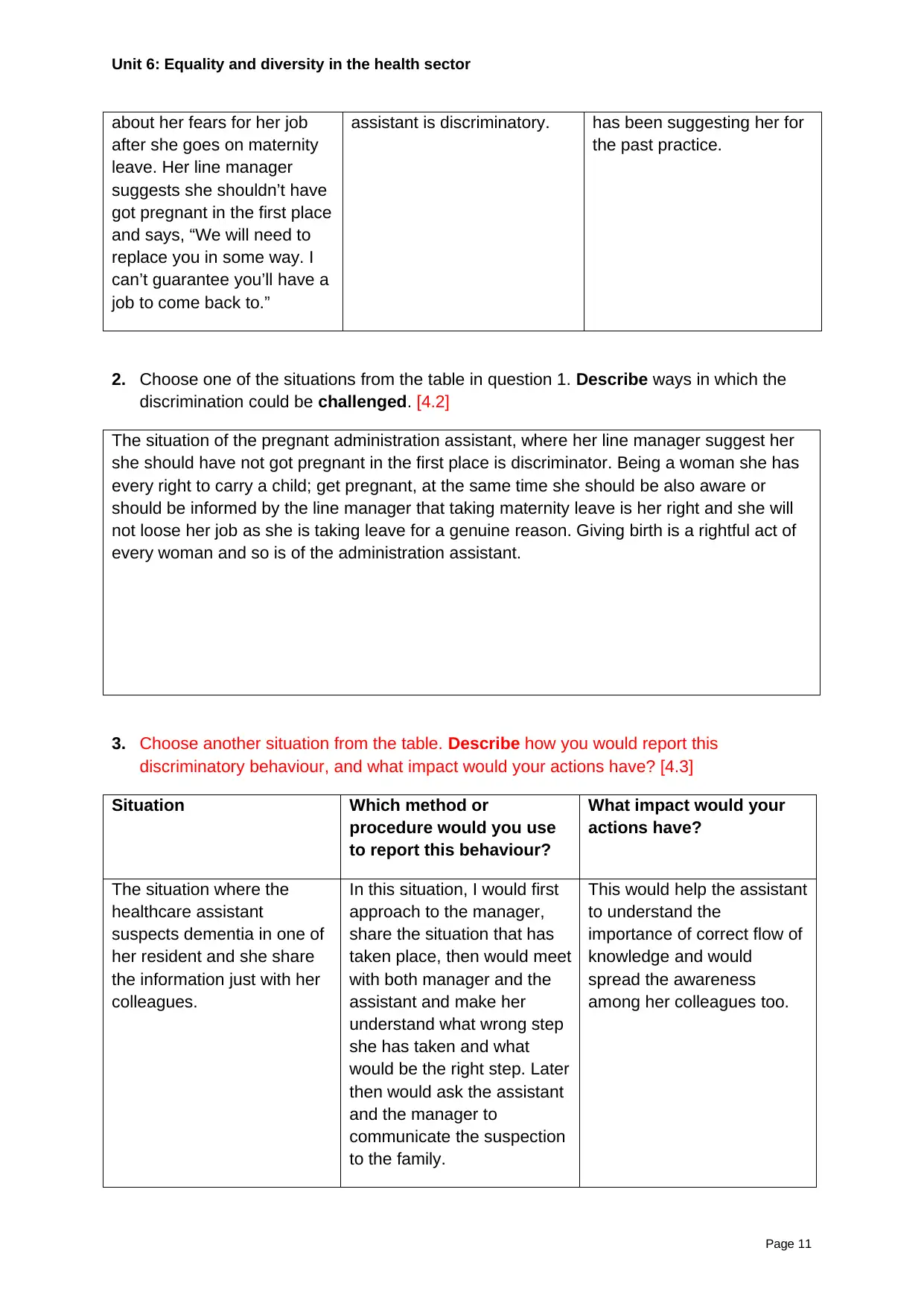
Unit 6: Equality and diversity in the health sector
about her fears for her job
after she goes on maternity
leave. Her line manager
suggests she shouldn’t have
got pregnant in the first place
and says, “We will need to
replace you in some way. I
can’t guarantee you’ll have a
job to come back to.”
assistant is discriminatory. has been suggesting her for
the past practice.
2. Choose one of the situations from the table in question 1. Describe ways in which the
discrimination could be challenged. [4.2]
The situation of the pregnant administration assistant, where her line manager suggest her
she should have not got pregnant in the first place is discriminator. Being a woman she has
every right to carry a child; get pregnant, at the same time she should be also aware or
should be informed by the line manager that taking maternity leave is her right and she will
not loose her job as she is taking leave for a genuine reason. Giving birth is a rightful act of
every woman and so is of the administration assistant.
3. Choose another situation from the table. Describe how you would report this
discriminatory behaviour, and what impact would your actions have? [4.3]
Situation Which method or
procedure would you use
to report this behaviour?
What impact would your
actions have?
The situation where the
healthcare assistant
suspects dementia in one of
her resident and she share
the information just with her
colleagues.
In this situation, I would first
approach to the manager,
share the situation that has
taken place, then would meet
with both manager and the
assistant and make her
understand what wrong step
she has taken and what
would be the right step. Later
then would ask the assistant
and the manager to
communicate the suspection
to the family.
This would help the assistant
to understand the
importance of correct flow of
knowledge and would
spread the awareness
among her colleagues too.
Page 11
about her fears for her job
after she goes on maternity
leave. Her line manager
suggests she shouldn’t have
got pregnant in the first place
and says, “We will need to
replace you in some way. I
can’t guarantee you’ll have a
job to come back to.”
assistant is discriminatory. has been suggesting her for
the past practice.
2. Choose one of the situations from the table in question 1. Describe ways in which the
discrimination could be challenged. [4.2]
The situation of the pregnant administration assistant, where her line manager suggest her
she should have not got pregnant in the first place is discriminator. Being a woman she has
every right to carry a child; get pregnant, at the same time she should be also aware or
should be informed by the line manager that taking maternity leave is her right and she will
not loose her job as she is taking leave for a genuine reason. Giving birth is a rightful act of
every woman and so is of the administration assistant.
3. Choose another situation from the table. Describe how you would report this
discriminatory behaviour, and what impact would your actions have? [4.3]
Situation Which method or
procedure would you use
to report this behaviour?
What impact would your
actions have?
The situation where the
healthcare assistant
suspects dementia in one of
her resident and she share
the information just with her
colleagues.
In this situation, I would first
approach to the manager,
share the situation that has
taken place, then would meet
with both manager and the
assistant and make her
understand what wrong step
she has taken and what
would be the right step. Later
then would ask the assistant
and the manager to
communicate the suspection
to the family.
This would help the assistant
to understand the
importance of correct flow of
knowledge and would
spread the awareness
among her colleagues too.
Page 11

Unit 6: Equality and diversity in the health sector
Page 12
Page 12
⊘ This is a preview!⊘
Do you want full access?
Subscribe today to unlock all pages.

Trusted by 1+ million students worldwide
1 out of 13
Related Documents
Your All-in-One AI-Powered Toolkit for Academic Success.
+13062052269
info@desklib.com
Available 24*7 on WhatsApp / Email
![[object Object]](/_next/static/media/star-bottom.7253800d.svg)
Unlock your academic potential
Copyright © 2020–2025 A2Z Services. All Rights Reserved. Developed and managed by ZUCOL.





